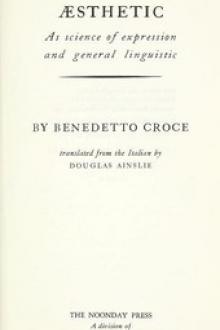The Sense of Beauty by George Santayana (ebooks children's books free .TXT) 📖

- Author: George Santayana
- Performer: -
Book online «The Sense of Beauty by George Santayana (ebooks children's books free .TXT) 📖». Author George Santayana
And another point. The wider diffusion of sensuous beauty makes it as it were the poor man's good. Fewer factors are needed to produce it and less training to appreciate it. The senses are indispensable instruments of labour, developed by the necessities of life; but their perfect development produces a harmony between the inward structure and instinct of the organ and the outward opportunities for its use; and this harmony is the source of continual pleasures. In the sphere of sense, therefore, a certain cultivation is inevitable in man; often greater, indeed, among rude peoples, perhaps among animals, than among those whose attention takes a wider sweep and whose ideas are more abstract. Without requiring, therefore, that a man should rise above his station, or develope capacities which his opportunities will seldom employ, we may yet endow his life with aesthetic interest, if we allow him the enjoyment of sensuous beauty. This enriches him without adding to his labour, and flatters him without alienating him from his world.
Taste, when it is spontaneous, always begins with the senses. Children and savages, as we are so often told, delight in bright and variegated colours; the simplest people appreciate the neatness of muslin curtains, shining varnish, and burnished pots. A rustic garden is a shallow patchwork of the liveliest flowers, without that reserve and repose which is given by spaces and masses. Noise and vivacity is all that childish music contains, and primitive songs add little more of form than what is required to compose a few monotonous cadences. These limitations are not to be regretted; they are a proof of sincerity. Such simplicity is not the absence of taste, but the beginning of it.
A people with genuine aesthetic perceptions creates traditional forms and expresses the simple pathos of its life, in unchanging but significant themes, repeated by generation after generation. When sincerity is lost, and a snobbish ambition is substituted bad taste comes in. The essence of it is a substitution of non-aesthetic for aesthetic values. To love glass beads because they are beautiful is barbarous, perhaps, but not vulgar; to love jewels only because they are dear is vulgar, and to betray the motive by placing them ineffectively is an offence against taste. The test is always the same: Does the thing itself actually please? If it does, your taste is real; it may be different from that of others, but is equally justified and grounded in human nature. If it does not, your whole judgment is spurious, and you are guilty, not of heresy, which in aesthetics is orthodoxy itself, but of hypocrisy, which is a self-excommunication from its sphere.
Now, a great sign of this hypocrisy is insensibility to sensuous beauty. When people show themselves indifferent to primary and fundamental effects, when they are incapable of finding pictures except in frames or beauties except in the great masters, we may justly suspect that they are parrots, and that their verbal and historical knowledge covers a natural lack of aesthetic sense. Where, on the contrary, insensibility to higher forms of beauty does not exclude a natural love of the lower, we have every reason to be encouraged; there is a true and healthy taste, which only needs experience to refine it. If a man demands light, sound, and splendour, he proves that he has the aesthetic equilibrium; that appearances as such interest him, and that he can pause in perception to enjoy. We have but to vary his observation, to enlarge his thought, to multiply his discriminations — all of which education can do — and the same aesthetic habit will reveal to him every shade of the fit and fair. Or if it should not, and the man, although sensuously gifted, proved to be imaginatively dull, at least he would not have failed to catch an intimate and wide-spread element of effect. The beauty of material is thus the groundwork of all higher beauty, both in the object, whose form and meaning have to be lodged in something sensible, and in the mind, where sensuous ideas, being the first to emerge, are the first that can arouse delight.
PART III
FORM
There is a beauty of form.
§ 19. The most remarkable and characteristic problem of aesthetics is that of beauty of form. Where there is a sensuous delight, like that of colour, and the impression of the object is in its elements agreeable, we have to look no farther for an explanation of the charm we feel. Where there is expression, and an object indifferent to the senses is associated with other ideas which are interesting, the problem, although complex and varied, is in principle comparatively plain. But there is an intermediate effect which is more mysterious, and more specifically an effect of beauty. It is found where sensible elements, by themselves indifferent, are so united as to please in combination. There is something unexpected in this phenomenon, so much so that those who cannot conceive its explanation often reassure themselves by denying its existence. To reduce beauty of form, however, to beauty of elements would not be easy, because the creation and variation of effect, by changing the relation of the simplest lines, offers too easy an experiment in refutation. And it would, moreover, follow to the comfort of the vulgar that all marble houses are equally beautiful.
To attribute beauty of form to expression is more plausible. If I take the meaningless short lines in the figure and arrange them in the given ways, intended to represent the human face, there appear at once notably different aesthetic values.
![[Illustration: sense01]](@public@vhost@g@gutenberg@html@files@26842@26842-h@images@sense01.png)
![[Illustration: sense02]](@public@vhost@g@gutenberg@html@files@26842@26842-h@images@sense02.png)
Two of the forms are differently grotesque and one approximately beautiful. Now these effects are due to the expression of the lines; not only because they make one think of fair or ugly faces, but because, it may be said, these faces would in reality be fair or ugly according to their expression, according to the vital and moral associations of the different types.
Nevertheless, beauty of form cannot be reduced to expression without denying the existence of immediate aesthetic values altogether, and reducing them all to suggestions of moral good. For if the object expressed by the form, and from which the form derives its value, had itself beauty of form, we should not advance; we must come somewhere to the point where the expression is of something else than beauty; and this something else would of course be some practical or moral good. Moralists are fond of such an interpretation, and it is a very interesting one. It puts beauty in the same relation to morals in which morals stand to pleasure and pain; both would be intuitions, qualitatively new, but with the same materials; they would be new perspectives of the same object.
But this theory is actually inadmissible. Innumerable aesthetic effects, indeed all specific and unmixed ones, are direct transmutations of pleasures and pains; they express nothing extrinsic to themselves, much less moral excellences. The detached lines of our figure signify nothing, but they are not absolutely uninteresting; the straight line is the simplest and not the least beautiful of forms. To say that it owes its interest to the thought of the economy of travelling over the shortest road, or of other practical advantages, would betray a feeble hold on psychological reality. The impression of a straight line differs in a certain almost emotional way from that of a curve, as those of various curves do from one another. The quality of the sensation is different, like that of various colours or sounds. To attribute the character of these forms to association would be like explaining sea-sickness as the fear of shipwreck. There is a distinct quality and value, often a singular beauty, in these simple lines that is intrinsic in the perception of their form.
It would be pedantic, perhaps, anywhere but in a treatise on aesthetics, to deny to this quality the name of expression; we might commonly say that the circle has one expression and the oval another. But what does the circle express except circularity, or the oval except the nature of the ellipse? Such expression expresses nothing; it is really impression. There may be analogy between it and other impressions; we may admit that odours, colours, and sounds correspond, and may mutually suggest one another; but this analogy is a superadded charm felt by very sensitive natures, and does not constitute the original value of the sensations. The common emotional tinge is rather what enables them to suggest one another, and what makes them comparable. Their expression, such as it is, is therefore due to the accident that both feelings have a kindred quality; and this quality has its effectiveness for sense independently of the perception of its recurrence in a different sphere. We shall accordingly take care to reserve the term "expression" for the suggestion of some other and assignable object, from which the expressive thing borrows an interest; and we shall speak of the intrinsic quality of forms as their emotional tinge or specific value.
Physiology of the perception of form.
§ 20. The charm of a line evidently consists in the relation of its parts; in order to understand this interest in spatial relations, we must inquire how they are perceived.[4] If the eye had its sensitive surface, the retina, exposed directly to the light, we could never have a perception of form any more than in the nose or ear, which also perceive the object through media. When the perception is not through a medium, but direct, as in the case of the skin, we might get a notion of form, because each point of the object would excite a single point in the skin, and as the sensations in different parts of the skin differ in quality, a manifold of sense, in which discrimination of parts would be involved, could be presented to the mind. But when the perception is through a medium, a difficulty arises.
Any point, α, in the object will send a ray to every point, a', b', c', of the sensitive surface; every point of the retina will therefore be similarly affected, since each will receive rays from every part of the object.
![[Illustration: sense03]](@public@vhost@g@gutenberg@html@files@26842@26842-h@images@sense03.png)
If all the rays from one point of the object, a, are to be concentrated on a corresponding point of the retina, α, which would then become the exclusive representative of α, we must have one or more refracting surfaces interposed, to gather the rays together. The presence of the lens, with its various coatings, has made representation of point by point possible for the eye. The absence of such an instrument makes the same sort of representation impossible to other senses, such as the nose, which does not smell in one place the effluvia of one part of the environment and in another place the effluvia of another, but smells indiscriminately the combination of all. Eyes without lenses like those possessed by some animals, undoubtedly give only a consciousness of diffused light, without the possibility of boundaries or divisions in the field of view. The abstraction of colour from form is therefore by no means an artificial one, since, by a simplification of the organ of sense, one may be perceived without the other.
But even if the lens enables the eye to receive a distributed image of the object, the manifold which consciousness would perceive would not be necessarily a manifold of parts juxtaposed in space. Bach point of the retina might send to the brain a detached impression; these might be comparable, but not necessarily in their spatial position. The ear sends to the brain such a manifold of impressions (since the ear also has an apparatus by which various external differences in rapidity of vibrations are distributed into different parts of the organ). But this discriminated manifold is a manifold of pitches, not of positions. How does





Comments (0)